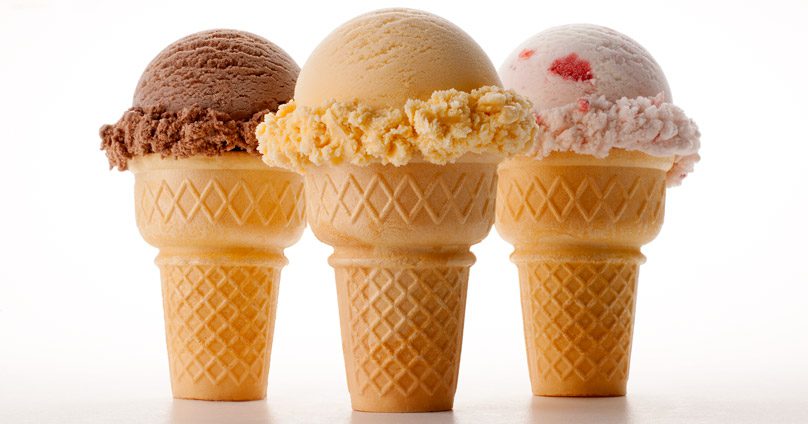It’s vital to understand what your product is made up of, so identifying the amount of milk-fat also known as butterfat and air also known as over run is imperative. Why the big deal, because establishing both can equate to the total cost of goods (cog’s) and gross profit.
Different fat percentages represent different categories in frozen dairy desserts, listed are the the terms and specifications.
- Super premium ice cream contains 14% – 16% butterfat
- Premium ice cream contains 12% – 14% butterfat
- Gelato is not regulated in the US and usually contains 3% – 8% butterfat
- Soft Serve or Reduced Fat ice cream (think Dairy Queen) contains 3% – 6% butterfat
- Ice Milk contains 3.5% butterfat which is the same as whole milk
- Sherbet in the US contains 1% – 2% butterfat
- Sorbet and Italian Ice contains no dairy and falls under other standards
Understanding terminology:
Ice Cream in the US has to contain at least 10% butterfat (BF) and less than 1.4% egg yolk according to FDA regulations, Title 21
Frozen Custard in the US contains needs at least 10% butterfat and at least 1.4% egg yolk, also known as French Ice Cream.
Sorbet does not include dairy and primarily composed of water, fruit puree, cane sugar and stabilizer gums and find it to be smoother than Italian Ice. Italian Ice also called Shaved Ice consists of zero dairy and composed of water, flavor, cane sugar and gum stabilizer.
How overrun occurs:
Overrun (OR) or air added to increase volume, occurs during the freezing and churning process and to be clear, not pumped in. A liquid base mix at 38? – 40? is poured or pumped into a freezer. The freezer cylinder is horizontal, the interior cylinder wall/surface is colder at 20? – 25?, so when the liquid base comes in contact with the surface, it creates a very thin layer of frozen product stuck to the surface.
The thin layer is scraped off by using a dasher/blade, which is basically a spiral “churner” with a knife sharp edge blade usually made of steel or special plastic. As the dasher spins clock-wise, the the blade skims the surface wall and the frozen product falls back into the base. If all is working correctly, the liquid base, becomes a consistency of a thick malted shake and a draw temperature of around 27? in 7 – 9 minutes.
Determine the amount of overrun or air:
Depending on the amount of butterfat in the product and freezing time process, the amount of air “folded” or churned into the product will vary. As previously outlined, the amount of fat and air making up your product will determine the weight, creaminess, cost of goods and profit margin. A super premium, let’s say 16% BF with 30% OR is heavier and creamier and has a higher cost of goods, when compared to a economical grade with 10% BF and 100% OR. In gross weight comparison, a pint of super premium ice cream can weight about 480 grams, while the economy grade can be as low as 280 grams.
Pick-up numerous pints at your local grocery store and test for yourself. In some instances you’ll discover some lighter in weight brands are even higher in cost than the heavier ones and typically the lighter is a boutique brand making claim that’s it’s the best the world has ever tasted.
Determining butterfat and overrun:
Typically I find clients get into the frozen dairy and non-dairy business for a couple of reasons. One, to simply make money and two, for the love of the product. Depending on the reason you fall under, making money typically represents a low fat, high overrun product, containing not so natural ingredients and flavoring. If you’re in for the love of it like I am, then high fat, low overrun and natural ingredients (I call the good stuff).
Make no mistake, you can make a high quality product that’s high in fat, low in overrun and natural ingredients and still make significant profits.
- Super premium ice cream with 30% OR = 1 x 1.3 finished product
- Economy grade ice cream with 100% OR = 1 x 2 finished product (pour in one liquid gallon and get two finished out)
Cream and milk:
- Heavy cream is 36% – 40% butterfat
- Heavy whipping cream is 30-36% with other ingredients added to make it whip
- Light cream is about 20% butterfat, with one or two added ingredients
- Half-and-half is around 12% butterfat and can vary + or – depending on the brand or from 50% light cream and 50% milk
- Whole milk is 3.25% – 3.5% butterfat
- Low-fat milk is 1% butterfat and the rest is water
- Skim milk has less than 0.5% butterfat and the rest is water
Keep overrun and butterfat in mind when concocting your dairy based ice cream, gelato, frozen yogurt or custard, it will be key to the customer you want to attract and the cost of doing business.
Confused and overwhelmed, schedule time with Darryl, he can save you time and walk you through what’s best for your brand.
- Ethics In Using Madagascar Vanilla - November 21, 2023
- Money To Start Your Business - July 9, 2023
- Top 25 Common Myths About Ice Cream Co-Pack Manufacturers - April 22, 2023

